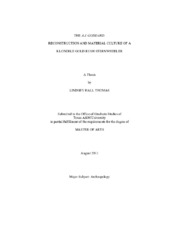The A.J. Goddard: Reconstruction and Material Culture of a Klondike Gold Rush Sternwheeler
Abstract
The A.J. Goddard, a steamboat built for the Klondike Gold Rush of 1897-1898, wrecked in 1901 on Lake Laberge, Yukon Territory, where it lay undisturbed until its rediscovery in 2008 by the Yukon River Survey Project, directed by John Pollack. The complete and undisturbed nature of the wreck site, which is the only known site from this period to show such remarkable preservation, provides an unparalleled opportunity for studying the construction features of one of the Klondike steamboats and its associated material culture.
The wreck of the A.J. Goddard is the only known surviving example of a small, prefabricated sternwheeler from the Yukon River's sternwheeler days. Due to the nature of its construction and building material, the A.J. Goddard represents a period of vast change in shipbuilding techniques, and is part of the fascinating juxtaposition between traditional wooden boats and a new, prefabricated industrial solution to boatbuilding. Work thus far has revealed that the A.J. Goddard possessed a simple design and construction, likely not one developed specifically for the Yukon River. It appears that the need to carry it over a mountain influenced its design more than the qualities of the Yukon River. Modifications were made over the course of its short career to make it more suitable, but its tragic end indicates that it was not a good choice for open-water navigation, though it admirably and successfully fulfilled its mission of serving throughout the gold rush. Though it was not ideally suited for the river and lakes environment where it was built, the quickness and ingenuity with which the vessel was constructed made it one of the few vessels, out of the thousands that set out for the Yukon in the summer of 1898, to actually make it to Dawson in time for the gold rush without being delayed by ice in the north, as so many were.
Field seasons were conducted in 2009 and 2010 that focused on recording the boat's construction features and artifacts. Select artifacts were recovered for study and display in Whitehorse, Yukon Territory with the intention of creating an exhibit for the Yukon public.
Citation
Thomas, Lindsey Hall (2011). The A.J. Goddard: Reconstruction and Material Culture of a Klondike Gold Rush Sternwheeler. Master's thesis, Texas A&M University. Available electronically from https : / /hdl .handle .net /1969 .1 /ETD -TAMU -2011 -08 -9777.


